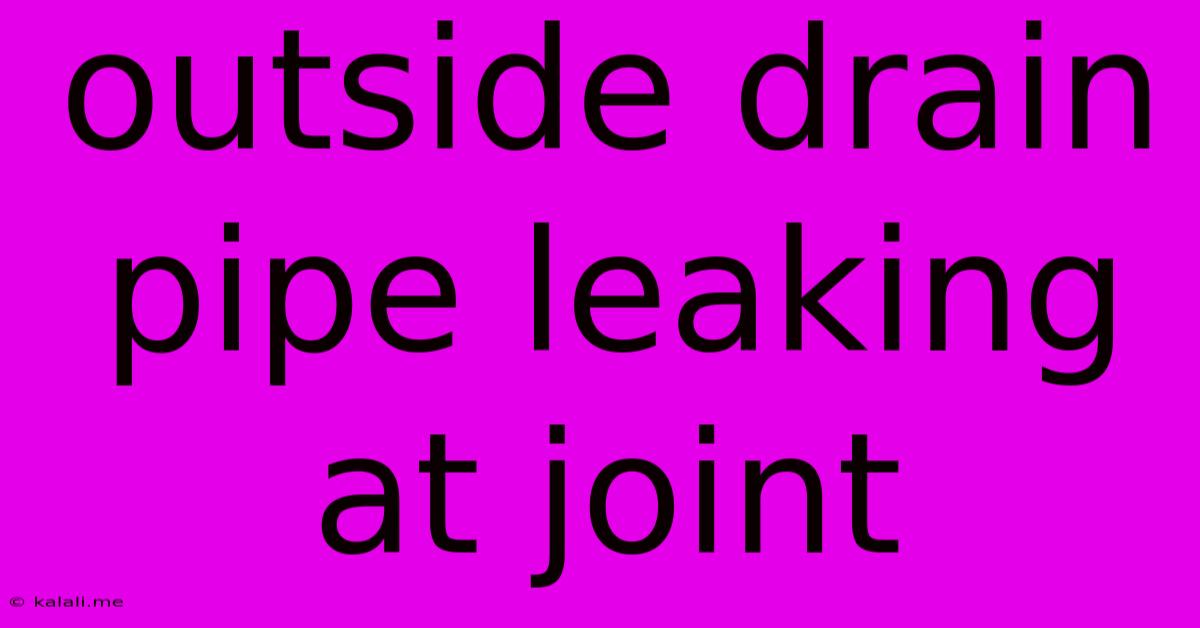Outside Drain Pipe Leaking At Joint
Kalali
May 22, 2025 · 4 min read

Table of Contents
Outside Drain Pipe Leaking at Joint: Diagnosis and Repair
A leaking outside drain pipe at a joint is a common plumbing problem that can lead to significant property damage if left unaddressed. This article will guide you through diagnosing the leak, understanding the causes, and tackling the repair yourself, or knowing when to call a professional. Ignoring a leaking drain pipe can cause erosion, foundation damage, and unpleasant odors.
Understanding the Problem:
The joint, the connection point between two sections of pipe, is often the weakest point in the drainage system. Leaks can manifest as a steady drip, a slow seep, or a significant gush of water, depending on the severity of the damage. The location of the leak, whether it's near the house foundation or further down the line, can also impact the urgency of the repair. Identifying the exact source of the leak is crucial for effective repair.
Causes of Leaks at Drain Pipe Joints:
Several factors can contribute to leaks at drain pipe joints:
- Corrosion: Over time, metal pipes, especially cast iron, are prone to rust and corrosion, weakening the joint and causing leaks. This is especially true in areas with harsh weather conditions.
- Settlement: Ground movement due to soil erosion or shifting can put stress on the pipe joints, causing them to crack or separate.
- Root Intrusion: Tree and plant roots can aggressively seek out moisture, penetrating pipe joints and causing blockages and leaks.
- Poor Installation: Initially faulty installation, such as improper sealing or inadequate joint support, can manifest as leaks years later.
- Freeze-thaw Cycles: In colder climates, water freezing and expanding inside the pipes can put immense pressure on the joints, leading to cracks and leaks. This is particularly true for exposed pipes.
- Joint Degradation: The sealant used at the joint, whether it's cement, putty, or a specialized pipe joint sealant, can degrade over time due to exposure to the elements, leading to cracks and leaks.
Diagnosing the Leak:
Before attempting any repair, carefully inspect the affected area:
- Locate the Leak: Pinpoint the precise location of the leak to determine the extent of the damage and the best repair method.
- Check for Obstructions: A blockage upstream can increase pressure on the joint, exacerbating the leak. Clear any obstructions before proceeding.
- Assess the Pipe Material: Identifying the pipe material (PVC, cast iron, ABS) will help you choose the appropriate repair method and materials.
- Evaluate the Severity: Determine if the leak is minor (a slow drip) or major (a significant flow). A major leak may require immediate professional attention.
Repairing the Leak:
The repair method depends on the severity of the leak, the pipe material, and your DIY skills. Minor leaks might be temporarily patched, while major leaks necessitate more involved repairs or replacement.
- Temporary Patches (for minor leaks only): For small leaks in PVC or ABS pipes, a rubber or PVC patch and sealant can provide a temporary fix. This isn't a long-term solution, however.
- Joint Sealant: Applying a high-quality pipe joint sealant can seal minor gaps and cracks in the joint. Ensure the surface is clean and dry before application.
- Replacing the Joint: For more significant leaks or severely damaged joints, replacing the affected section of pipe is the most effective solution. This typically involves cutting out the damaged section and fitting a new section with appropriate connectors and sealant.
When to Call a Professional:
While some minor leaks can be addressed with DIY solutions, it's crucial to call a licensed plumber in these situations:
- Major Leaks: Significant water loss requires immediate professional attention to prevent further damage.
- Complex Repairs: If the repair requires extensive excavation or specialized tools, it's best left to professionals.
- Underlying Issues: If you suspect a more significant plumbing problem, like root intrusion or severe pipe corrosion, a plumber can conduct a thorough inspection and recommend the appropriate solution.
- Uncertainty: If you're unsure about any aspect of the repair process, it's always safer to call a professional.
Addressing a leaking outside drain pipe promptly is vital to prevent costly repairs and protect your property. By understanding the causes, diagnosing the problem accurately, and choosing the appropriate repair method, you can effectively tackle this common plumbing issue. Remember, safety always comes first – don't hesitate to call a professional when needed.
Latest Posts
Latest Posts
-
What Does No Guard Do In Pokemon
May 22, 2025
-
X 2 1 X 1 X 1
May 22, 2025
-
How Many Cups Is A Box Of Powdered Sugar
May 22, 2025
-
How Long Does Gas Last In A Gas Can
May 22, 2025
-
Freezer Not Working But Refrigerator Is
May 22, 2025
Related Post
Thank you for visiting our website which covers about Outside Drain Pipe Leaking At Joint . We hope the information provided has been useful to you. Feel free to contact us if you have any questions or need further assistance. See you next time and don't miss to bookmark.